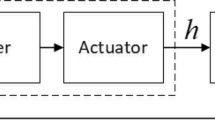Abstract
We consider a mathematical model of a catamaran with a wind turbine consisting of a hull equipped with an air propeller and a water propeller. The wind-receiving propeller converts wind energy into rotational energy and transfers it via the transmission system to the propeller, which creates a pulling force. The superiority of this force over the sum of the sailing resistance of the propeller and the hydrodynamic resistance of the catamaran hull provides the possibility of upwind acceleration. The shaft system connecting the air and water propeller suggests the possibility of changing the rotation transmission ratio. Steady modes of motion have been studied, their stability has been analyzed, and parameters have been found that provide the highest hull speed when moving upwind.


Similar content being viewed by others
REFERENCES
B. V. Grigor’ev and G. P. Lysenko, ‘‘Characteristics of vessels with wind engines,’’ Tr. Nikolaev. Korablestr. Inst. 155, 80–85 (1979).
G. P. Lysenko, Transport Wind Engines (Nauka, Moscow, 2014).
M. A. Garbuz, A. P. Holub, and L. A. Klimina, ‘‘The modeling of the catamaran equipped with the wind turbine,’’ in 14th Int. Conf. on Stability and Oscillations of Nonlinear Control Systems (Pyatnitskiy’s Conf.) (STAB), Moscow, 2018 (IEEE, 2018), pp. 1–2. https://doi.org/10.1109/STAB.2018.8408355
B. Ya. Lokshin and V. A. Samsonov, Problem on Motion of a Body in a Resisting Medium (Mosk. Gos. Univ., Moscow, 2012).
Ya. I. Voitkunskii, Handbook on Theory of Ship (Sudostroenie, Leningrad, 1986), vol. 1.
M. S. Adaramola and P.-A. Krogstad, ‘‘Experimental investigation of wake effects on wind turbine performance,’’ Renewable Energy 36, 2078–2086 (2011). https://doi.org/10.1016/j.renene.2011.01.024
M. A. Garbuz, ‘‘Modes of motion of wind catamaran: Stability, bifurcations,’’ in Proc. of Congress of Young Scientists (Mosk. Gos. Univ., Moscow, 2020), pp. 36–42.
D. Zingg and T. Chisholm, ‘‘Jacobian-free Newton–Krylov methods: Issues and solutions,’’ in Computational Fluid Dynamics 2006, Ed. by H. Deconinck and E. Dick (Springer, Berlin, 2009), pp. 237–242. https://doi.org/10.1007/978-3-540-92779-2_35
Author information
Authors and Affiliations
Corresponding author
Ethics declarations
The author declares that he has no conflicts of interest.
About this article
Cite this article
Garbuz, M.A. Dynamic Model of Ship Wind Turbine with Transmission. Moscow Univ. Mech. Bull. 77, 27–31 (2022). https://doi.org/10.3103/S0027133022010022
Received:
Published:
Issue Date:
DOI: https://doi.org/10.3103/S0027133022010022




